This article was published in Scientific American’s former blog network and reflects the views of the author, not necessarily those of Scientific American
Among the most spectacular and remarkable of dinosaurs are the ceratopsians or horned dinosaurs, and in particular the mostly enormous Late Cretaceous ceratopsids. This is the group (technically: Ceratopsidae) that includes Triceratops and the other familiar quadrupedal forms. All possessed a giant bony frill at the back of the skull, and most (but not all) also possessed a nose horn and paired brow or supraorbital horns. These features – the frill and horns – are familiar and oft-discussed in both the popular and technical literature and there’s a lot to say about them. There are, however, a number of additional remarkable features of the ceratopsid skull that are hardly ever discussed and which you may never have heard of before, and it’s those features that I’m going to discuss here and in one or two subsequent articles.
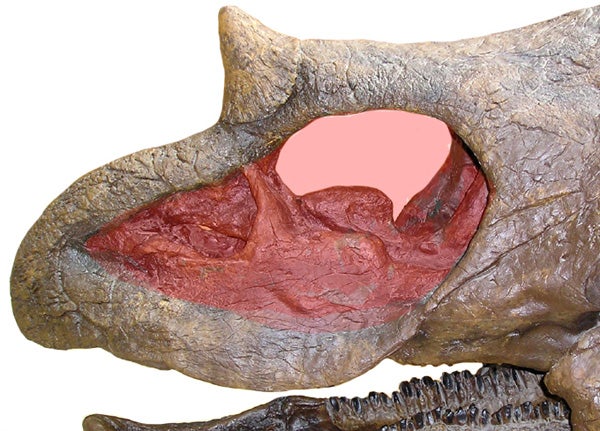
The naris - the bony nostril opening - is enormous in ceratopsids like Triceratops here. Credit: Darren Naish
We’ll start with the nasal region. The ceratopsid bony nostril opening – the structure technically known as the naris (plural: nares) – is ridiculous. It’s enormous and cavernous, occupying a vast region on the side of the snout and clearly being way larger than needed for the fleshy nostril alone. As is now well known in the palaeontological community (thanks to key work by Larry Witmer), both nostril position in living reptiles and data pertaining to blood vessel and nerve impressions in fossils indicate that the fleshy nostrils of fossil dinosaurs would virtually always have been positioned well anteriorly in the bony naris (Witmer 2001). Of interest is that Witmer was not the first to make this proposal: Thomas Lehman had argued in an earlier paper for anteriorly positioned fleshy nostrils in ceratopsids (Lehman 1998).
On supporting science journalism
If you're enjoying this article, consider supporting our award-winning journalism by subscribing. By purchasing a subscription you are helping to ensure the future of impactful stories about the discoveries and ideas shaping our world today.
Anyway, in a clean fossil, you can of course see right through the nasal cavity from one side to the other, both nares forming a giant bony window.
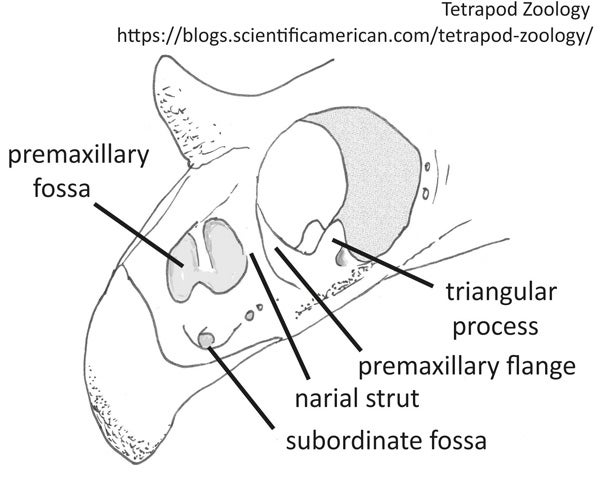
Key structures of the chasmosaurine ceratopsid narial region, based on a diagram in Lehman (1998). Credit: Darren Naish
However, the anterior part of that ‘window’ is occupied by a large and complex set of bony structures, those present in chasmosaurines (the mostly long-frilled ceratopsid group that includes Triceratops and Chasmosaurus and so on) being substantially more complex than they are in centrosaurines (the mostly short-frilled group that includes Centrosaurus, Pachyrhinosaurus and so on). Firstly, there are paired narial struts: vertical, pillar-like thickenings that extend from the floor of the nasal cavity to its roof. These struts are located on either side of a midline wall or sheet of bone, properly termed the premaxillary flange or septal flange. Anterior to the struts, the chasmosaurine flange possesses a prominent oval depression termed the septal foramen or fossa or premaxillary fossa or foramen or interpremaxillary fenestra (Dodson & Currie 1992, Forster 1996, Lehman 1998, Holmes et al. 2001, Campbell et al. 2016). The septal depression is divided into two in some taxa by an additional vertical strut. An additional concave region – the subordinate fossa – is present far anteriorly on the flange.
Paired mini-flanges – variously termed premaxillary processes or triangular flanges or triangular processes – project upwards and backwards from the bases of the narial struts into the main part of the nasal cavity. The outer edges of these structures are excavated by hollowed regions in some taxa. And there are other structures as well.
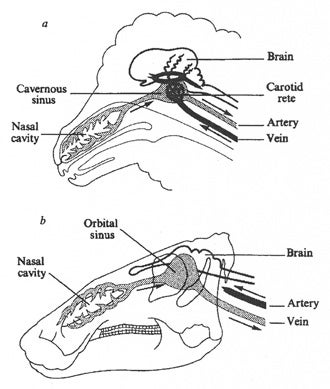
Wheeler (1978) proposed that the giant bony nostrils of ornithischians like the Edmontosaurus below housed giant blood vessels that had a key role in keeping the brain cool. The diagram at the top depicts a sheep, not Godzilla. Credit: Wheeler 1978
You get the point: ceratopsid bony nasal architecture was complicated and nuanced – that of chasmosaurines in particular – and the bony features mentioned here would likely have been enlarged or elaborated by cartilage in life.
Why the nares were this large and just what those internal structures relate to are the big questions. As usual, we don’t know exactly what was going on because we lack sufficient data on the soft tissues. It doesn’t look likely that they were muscle-attachment sites – the structures don’t have a surface texture indicative of muscle attachment. The possibility that some of the bony cavities might have been associated with enlarged blood vessel clusters (the nasal vestibular vascular plexus among them) or other vascular structures is plausible, and indeed Wheeler (1978) argued that the gigantic nares of Cretaceous ornithischians were extensively vascularised and had a key role in heat dissipation. It’s not a bad idea.
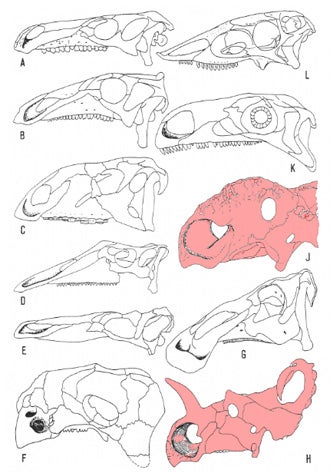
Big nostrils evolved more than once within dinosaurs (L is not a dinosaur but an aetosaur; a croc-line archosaur). But, as you can see in this montage from Osmólska (1979), ceratopsids win the game. Credit: Osmólska 1979
Osmólska (1979) proposed that the nares might have housed enlarged salt glands. However, it isn’t clear that such glands would have been at all necessary for these animals, nor would a salt-excreting gland located in the nasal region be predicted for extinct archosaurs given that archosaurian salt glands are otherwise associated with the supraorbital region. A link between the septal foramen and a vomeronasal organ has also been suggested (Lehman 1989, 1998), one of the few occasions in which the presence of a vomeronasal organ has been proposed for a dinosaur (general thinking is that such organs were not present in dinosaurs… but that’s a subject for another time). Support for this possibility is perhaps provided by the presence of a duct linking the septal foramen and the palate (Lehman 1998). Note that the presence of a vomeronasal organ cannot be seen, however, as the ‘explanation’ for the weird nasal anatomy of these dinosaurs given that other reptiles with vomeronasal organs (namely squamates) do not have the gigantic, complex nares we’re seeing here.
What might be the best explanation for this complex anatomy is that the openings and bony hollows on the septal flange were occupied by air-filled sacs and ducts, and connected to form what’s known as a pneumatic paranasal system (Sampson & Witmer 1999). Support for this view comes from the fact that what look like pneumatic passages are present at both the front and back of the naris and seemingly connect the system here with pneumaticity also present in the maxilla (Sampson & Witmer 1999).
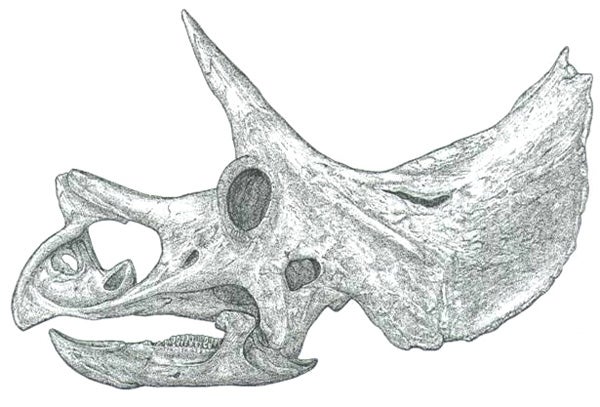
Another reminder, as if one were needed, of how huge and complex the ceratopsid naris is. This diagram depicts the Munich Triceratops specimen described by Ostrom & Wellnhofer (1986). Credit: Ostrom & Wellnhofer 1986
At this point it should be said that the ‘Sampson & Witmer 1999’ I’m citing here is a conference abstract and that full disclosure of the data relevant to this hypothesis of narial pneumaticity has yet to be fully published (to my knowledge), though I did attend the relevant talk and even have notes that I took. What it implies is that these dinosaurs possibly possessed complex and potentially inflatable pneumatic structures within the nasal region. A responsible scientist might not go any further than that.
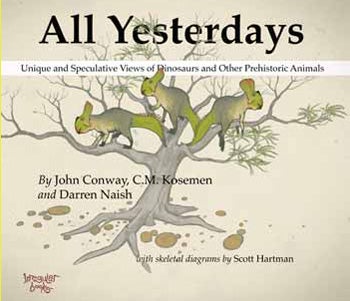
It's that book again. Credit: Irregular Books
But I’m one of the co-authors of All Yesterdays (Conway et al. 2012) and have never pretended to be responsible. I seriously regard it as plausible that ceratopsids possessed a series of inflatable and erectile nasal structures that were unveiled and inflated in display… that these animals had ‘nose balloons’ and soft display organs that were ceratopsian analogues of the inflatable facial structures long hypothesised to exist in hadrosaurs, and which would potentially have made them look about as ridiculous as displaying tragopans or turkeys. You might prefer a more conservative alternative, and maybe you’d be right. But these are dinosaurs, and they’re anything but conservative.
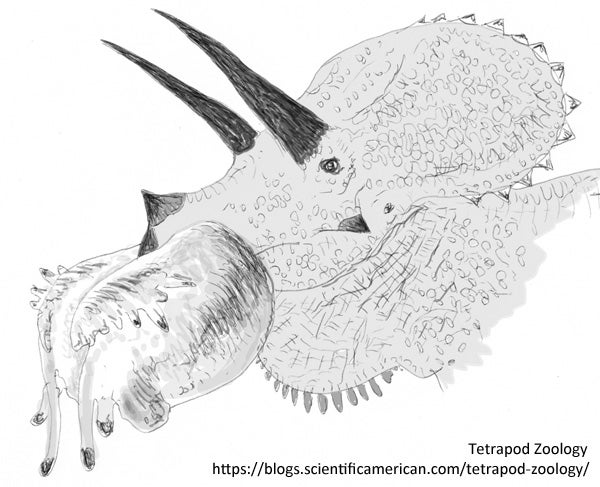
How outlandish is a speculative reconstruction like this? Yeah, it's pretty outlandish. Credit: Darren Naish
More on ceratopsian cranial anatomy sometime soon, next time moving away from the nasal region and more towards the skull roof. Ceratopsians have been covered quite a bit at Tet Zoo, though virtually all of the articles are now quite dated. See…
Tet Zoo picture of the day # 11 (or, speculations on omnivory in ceratopsids)
SVPCA 2007: dinosaurs attack (includes stuff on Psittacosaurus)
A month in dinosaurs (and pterosaurs): 3, Minotaurasaurus and giant chasmosaurines
Zuniceratops and the early acquisition and alleged dimorphism of ceratopsian brow horns
Did dinosaurs and pterosaurs practise mutual sexual selection?
Ryan et al.'s New Perspectives on Horned Dinosaurs: a review
Dinosaurs and their exaggerated structures: species recognition aids, or sexual display devices?
Refs - -
Dodson, P. & Currie, P. J. 1992. Neoceratopsia. In Weishampel, D. B., Dodson, P. & Osmólska, H. (eds) The Dinosauria (University of California Press, Berkeley), pp. 593-618.
Forster, C. A. 1996. New information on the skull of Triceratops. Journal of Vertebrate Paleontology 16, 246-258.
Holmes, R. B., Forster, C., Ryan, M. & Shepherd, K. M. 2001. A new species of Chasmosaurus (Dinosauria: Ceratopsia) from the Dinosaur Park Formation of southern Alberta. Canadian Journal of Earth Sciences 38, 1423-1438.
Lehman, T. M. 1989. Chasmosaurus mariscalensis, sp. nov., a new ceratopsian dinosaur from Texas. Journal of Vertebrate Paleontology 9, 137-162.
Lehman, T. M. 1998. A gigantic skull and skeleton of the horned dinosaur Pentaceratops sternbergi from New Mexico. Journal of Paleontology 72, 894-906.
Osmólska, H. 1979. Nasal salt gland in dinosaurs. Acta Palaeontologica Polonica 24, 205-215.
Ostrom, J. H. & Wellnhofer, P. 1986. The Munich specimen of Triceratops with a revision of the genus. Zitteliana 14, 111-158.
Sampson, S. D. & Witmer, L. M. 1999. Novel narial anatomy in ceratopsid dinosaurs. Journal of Vertebrate Paleontology 18 (Supp 3), 72A.
Wheeler, P. E. 1978. Elaborate CNS cooling structures in large dinosaurs. Nature 275, 441-443.
Witmer, L. M. 2001. Nostril position in dinosaurs and other vertebrates and its significance for nasal function. Science 293, 850-853.